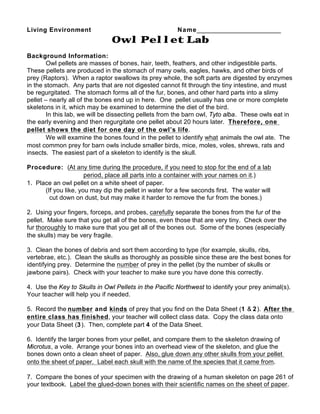
Biology owl pellet lab
- 1. Living Environment Name_______________________ Owl Pellet Lab Background Information: Owl pellets are masses of bones, hair, teeth, feathers, and other indigestible parts. These pellets are produced in the stomach of many owls, eagles, hawks, and other birds of prey (Raptors). When a raptor swallows its prey whole, the soft parts are digested by enzymes in the stomach. Any parts that are not digested cannot fit through the tiny intestine, and must be regurgitated. The stomach forms all of the fur, bones, and other hard parts into a slimy pellet – nearly all of the bones end up in here. One pellet usually has one or more complete skeletons in it, which may be examined to determine the diet of the bird. In this lab, we will be dissecting pellets from the barn owl, Tyto alba. These owls eat in the early evening and then regurgitate one pellet about 20 hours later. Therefore, one pellet shows the diet for one day of the owl’s life. We will examine the bones found in the pellet to identify what animals the owl ate. The most common prey for barn owls include smaller birds, mice, moles, voles, shrews, rats and insects. The easiest part of a skeleton to identify is the skull. Procedure: (At any time during the procedure, if you need to stop for the end of a lab period, place all parts into a container with your names on it.) 1. Place an owl pellet on a white sheet of paper. (If you like, you may dip the pellet in water for a few seconds first. The water will cut down on dust, but may make it harder to remove the fur from the bones.) 2. Using your fingers, forceps, and probes, carefully separate the bones from the fur of the pellet. Make sure that you get all of the bones, even those that are very tiny. Check over the fur thoroughly to make sure that you get all of the bones out. Some of the bones (especially the skulls) may be very fragile. 3. Clean the bones of debris and sort them according to type (for example, skulls, ribs, vertebrae, etc.). Clean the skulls as thoroughly as possible since these are the best bones for identifying prey. Determine the number of prey in the pellet (by the number of skulls or jawbone pairs). Check with your teacher to make sure you have done this correctly. 4. Use the Key to Skulls in Owl Pellets in the Pacific Northwest to identify your prey animal(s). Your teacher will help you if needed. 5. Record the number and kinds of prey that you find on the Data Sheet (1 & 2). After the entire class has finished, your teacher will collect class data. Copy the class data onto your Data Sheet (3). Then, complete part 4 of the Data Sheet. 6. Identify the larger bones from your pellet, and compare them to the skeleton drawing of Microtus, a vole. Arrange your bones into an overhead view of the skeleton, and glue the bones down onto a clean sheet of paper. Also, glue down any other skulls from your pellet onto the sheet of paper. Label each skull with the name of the species that it came from. 7. Compare the bones of your specimen with the drawing of a human skeleton on page 261 of your textbook. Label the glued-down bones with their scientific names on the sheet of paper.
- 2. Data Sheet 1. Number of skulls (or pairs of jawbones) in your owl pellet: ___________ 2. Prey species found in your pellet, and number of each: Species Number of individuals _____________________________ ________ _____________________________ ________ _____________________________ ________ 3. Class Record: A. Total number of pellets examined: _______________ B. Total number of prey animals found: ________________ C. Average number of prey animals per pellet: _______________ D. Number of animals of each species found for the class: Species Number Species Number Bird _______ Wandering Shrew _______ (Sorex vagrans) Rat _______ Bendire Shrew _______ (Rattus sp.) (Sorex bendiri) Townsend vole _______ Shrew mole _______ (Microtus townsendi) (Neurotrichus gibbsi) Creeping vole _______ Townsend mole _______ (Microtus oregoni) (Scapanus townsendi) Deer Mouse _______ Coast mole _______ (Peromyscus maniculatus) (Scapanus orarius) House Mouse _______ Other ______________ _______ (Mus musculus) 4. Remember that an owl produces one pellet per day. The listing in 3.D. represents the total prey eaten in the number of days listed in 3.A. Based on your class record, project the number of each species that an owl would eat in one year (365 days): Species Number Species Number Bird _______ Wandering Shrew _______ Rat _______ Bendire Shrew _______ Townsend vole _______ Shrew mole _______ Creeping vole _______ Townsend mole _______ Deer Mouse _______ Coast mole _______ House Mouse _______ Other ______________ _______
